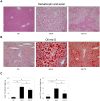The Selective SGLT2 Inhibitor Ipragliflozin Has a Therapeutic Effect on Nonalcoholic Steatohepatitis in Mice
- PMID: 26731267
- PMCID: PMC4701474
- DOI: 10.1371/journal.pone.0146337
The Selective SGLT2 Inhibitor Ipragliflozin Has a Therapeutic Effect on Nonalcoholic Steatohepatitis in Mice
Abstract
Background & aims: In recent years, nonalcoholic steatohepatitis (NASH) has become a considerable healthcare burden worldwide. Pathogenesis of NASH is associated with type 2 diabetes mellitus (T2DM) and insulin resistance. However, a specific drug to treat NASH is lacking. We investigated the effect of the selective sodium glucose cotransporter 2 inhibitor (SGLT2I) ipragliflozin on NASH in mice.
Methods: We used the Amylin liver NASH model (AMLN), which is a diet-induced model of NASH that results in obesity and T2DM. AMLN mice were fed an AMLN diet for 20 weeks. SGLT2I mice were fed an AMLN diet for 12 weeks and an AMLN diet with 40 mg ipragliflozin/kg for 8 weeks.
Results: AMLN mice showed steatosis, inflammation, and fibrosis in the liver as well as obesity and insulin resistance, features that are recognized in human NASH. Ipragliflozin improved insulin resistance and liver injury. Ipragliflozin decreased serum levels of free fatty acids, hepatic lipid content, the number of apoptotic cells, and areas of fibrosis; it also increased lipid outflow from the liver.
Conclusions: Ipragliflozin improved the pathogenesis of NASH by reducing insulin resistance and lipotoxicity in NASH-model mice. Our results suggest that ipragliflozin has a therapeutic effect on NASH with T2DM.
Conflict of interest statement
Figures





References
MeSH terms
Substances
LinkOut - more resources
Full Text Sources
Other Literature Sources
Medical

